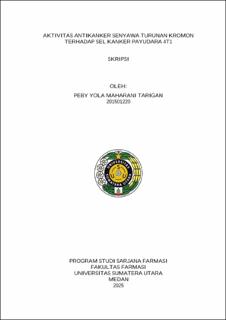| dc.contributor.advisor | Juwita, Nur Aira | |
| dc.contributor.advisor | Salim, Emil | |
| dc.contributor.author | Tarigan, Peby Yola Maharani | |
| dc.date.accessioned | 2025-04-08T06:20:05Z | |
| dc.date.available | 2025-04-08T06:20:05Z | |
| dc.date.issued | 2025 | |
| dc.identifier.uri | https://repositori.usu.ac.id/handle/123456789/102684 | |
| dc.description.abstract | Background: The proliferation of aberrant cells in uncoordinated body tissues is
what causes cancer, a malignant disease. Breast cancer is among the most
prevalent cancers among Indonesians, particularly women. As is well known,
chemotherapy is a common treatment for cancer. Chemotherapy has a lot of
negative consequences on the body, therefore researchers are looking for ways to
lessen or eliminate these side effects. Chromones are extensively found in nature
and are compounds with a benzoannelated γ-pyrone ring (4H-chromen4-one, 4H1-benzopyran-4-one). It is known that chromones have anti-cancer properties.
Objective: This study aims to test the cytotoxic effects of chromone-based
compounds on 4T1 breast cancer.
Methods: The stages of this research included sample collection and sample
processing, cytotoxic activity testing using the MTT (Microculture Tetrazolium
Test) Assay method and cell cycle inhibition. Grapphad Prism was then used to
evaluate the research data.
Results: Considering the finding of the study after testing 14 chromone
compounds, it is known that the compound 14 (3-hydroxy-2-(4-methoxyphenyl)-
6-methyl-8-nitro-4H-chromen-4-one) produces the lowest IC50 value of
0.000002683 µM with a concentration of 2000; 1000; 500; 250; 125; 6.25 µM,
where these results indicate that the compound is toxic or has an effect that can
kill 4T1 cancer cells. So that further repetition of the effect test on 4T1 cells. The
data shows that the compound (3-hydroxy-2-(4-methoxyphenyl)-6-methyl-8-
nitro-4H-chromen-4-one) has a very strong cytotoxic effect with an IC50 value of
2.346 µM. While doxorubicin which is a positive control has moderate cytotoxic
properties with an IC50 value of 23.36 µM.
Conclusion: The findings indicate that doxorubicin has moderate cytotoxic
qualities (IC50 value of 23.36 µM/mL) and compound 14 has extremely strong
cytotoxic properties (IC50 value of 2.346 µM/mL) against 4T1 breast cancer cells. | en_US |
| dc.language.iso | id | en_US |
| dc.publisher | Universitas Sumatera Utara | en_US |
| dc.subject | Anticancer | en_US |
| dc.subject | chromone compounds | en_US |
| dc.subject | 4T1 | en_US |
| dc.subject | cytotoxic | en_US |
| dc.title | Aktivitas Antikanker Senyawa Turunan Kromon Terhadap Sel Kanker Payudara 4T1 | en_US |
| dc.title.alternative | Anticancer Activity of Chromone Derivative Compounds Against 4T1 Breast Cancer Cells | en_US |
| dc.type | Thesis | en_US |
| dc.identifier.nim | NIM201501220 | |
| dc.identifier.nidn | NIDN0116018801 | |
| dc.identifier.nidn | NIDN0112028404 | |
| dc.identifier.kodeprodi | KODEPRODI48201#Farmasi | |
| dc.description.pages | 75 pages | en_US |
| dc.description.type | Skripsi Sarjana | en_US |
| dc.subject.sdgs | SDGs 3. Good Health And Well Being | en_US |


